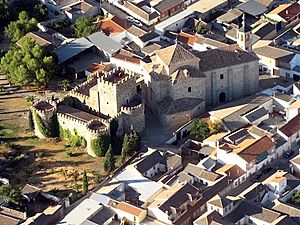Mascaraque facts for kids
Quick facts for kids
Mascaraque
|
|||
|---|---|---|---|

Aerial view of Mascaraque, showing Castle of Juan de Padilla and Mascaraque Church
|
|||
|
|||
| Country | Spain | ||
| Autonomous community | Castile-La Mancha | ||
| Province | Toledo | ||
| Comarca | Mancha Alta de Toledo | ||
| Area | |||
| • Total | 65 km2 (25 sq mi) | ||
| Elevation | 714 m (2,343 ft) | ||
| Population
(2018)
|
|||
| • Total | 439 | ||
| • Density | 6.75/km2 (17.49/sq mi) | ||
| Time zone | UTC+1 (CET) | ||
| • Summer (DST) | UTC+2 (CEST) | ||
Mascaraque is a small town in Spain. It is located in the province of Toledo, which is part of the Castile-La Mancha region. In 2006, about 550 people lived there.
Contents
A Look at Mascaraque's Past
The town of Mascaraque has a long history. It began during the time when Arabs ruled parts of Spain.
The Castle and Its Story
A castle was built here in the 1300s. Later, in 1518, it was rebuilt and became a grand fortress-palace. This palace belonged to a famous person named Juan de Padilla. Around this time, Mascaraque became known as a villa. This meant it was more important than smaller nearby villages.
Today, you can still see signs of its past importance. The town has its castle and several small palaces. These buildings have special shields that show their history.
Times of War and Bravery
During the War of Independence, which was a big conflict in Spain, many old records of Mascaraque were burned. Because of this, we don't know much about some parts of its early history.
In the 1800s, Mascaraque showed great courage. It stood strong against a group called the Carlistas. The town had its own local fighters to protect its people. In 1837 and 1838, during an invasion, Mascaraque was the only town in the area that refused to give supplies to the Carlist generals. Because of their bravery, the government later allowed Mascaraque to add the words "They did not fear" to its coat of arms. This phrase reminds everyone of their courage.
Mascaraque's Population Over Time
This section shows how the number of people living in Mascaraque has changed over many years.
| Historical population | ||
|---|---|---|
| Year | Pop. | ±% |
| 1900 | 1,092 | — |
| 1910 | 1,133 | +3.8% |
| 1920 | 1,113 | −1.8% |
| 1930 | 1,082 | −2.8% |
| 1940 | 1,002 | −7.4% |
| 1950 | 1,022 | +2.0% |
| 1960 | 1,017 | −0.5% |
| 1970 | 656 | −35.5% |
| 1981 | 587 | −10.5% |
| 1991 | 550 | −6.3% |
| 2001 | 474 | −13.8% |
| 2011 | 522 | +10.1% |
| 2021 | 413 | −20.9% |
| 2023 | 430 | +4.1% |
| Source: INE | ||
Important Buildings and Places
Mascaraque has some interesting old buildings that are worth seeing.
- Castle of Mascaraque: This castle was first built in the 1300s. It was damaged in wars over time. In the 1980s, a person named José Manuel Sierra Frade bought it and completely rebuilt it.
- Church of Santa María Magdalena: This church was built in the 1700s. It is a beautiful example of old architecture.
- Ermita de Los Cristos: This is a small chapel. Today, it holds copies of paintings by an artist named Juan Correa de Vivar.
Famous People from Mascaraque
Many interesting people have connections to Mascaraque.
- Pedro López de Padilla: He was a mayor of Toledo in the early 1500s. His son was Juan de Padilla, who owned the Mascaraque Castle.
- Juan Correa de Vivar (1510?–1566): He was a famous painter during the Renaissance period.
- Ana de Sande y Padilla (1610–1659): She was the first Duchess of Abrantes.
- Pablo Manzano Arellano (1855–1949): He was a painter.
- José Manuel Sierra Frade: He bought and rebuilt the Mascaraque Castle between 1980 and 1985.
- Faustino Lara Ibáñez: He is a modern-day novelist.
- María de Gracia Peralta Martín: She is a modern-day poet.
- Daniel Garbade (1957–): He is a Swiss artist and art director who has lived in Mascaraque since 1987. He is known for his sculptures.
- Javier Vallhonrat (1953–): He is a photographer who won a National Award in photography. He lived in Mascaraque until 1987.
See also
 In Spanish: Mascaraque para niños
In Spanish: Mascaraque para niños





